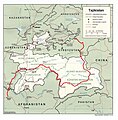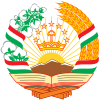The Tajikistan Portal
Tajikistan, officially the Republic of Tajikistan, is a landlocked country in Central Asia. Dushanbe is the capital and most populous city. Tajikistan is bordered by Afghanistan to the south, Uzbekistan to the west, Kyrgyzstan to the north, and China to the east. It is separated from Pakistan by Afghanistan's Wakhan Corridor. The territory was previously home to cultures of the Neolithic and the Bronze Age, including the city of Sarazm, and was later home to kingdoms ruled by people of faiths and cultures, including the Oxus civilization, Andronovo culture, Buddhism, Nestorian Christianity, Hinduism, Zoroastrianism, Manichaeism, and Islam. The area has been ruled by empires and dynasties, including the Achaemenid Empire, Sasanian Empire, Hephthalite Empire, Samanid Empire, and Mongol Empire. After being ruled by the Timurid Empire and Khanate of Bukhara, the Timurid Renaissance flourished. The region was later conquered by the Russian Empire and subsequently by the Soviet Union. Within the Soviet Union, the country's borders were drawn when it was part of Uzbekistan as an autonomous republic before becoming a full-fledged Soviet republic in 1929. (Full article...) Selected article - Did you know? -SubcategoriesGeneral imagesThe following are images from various Tajikistan-related articles on Wikipedia.
Related portalsReligions in Tajikistan Post Soviet states Other countries TopicsThings you can do
Selected image Credit: User:VargaA Dushanbe, Capital of Tajikistan
WikiProjectsAssociated WikimediaThe following Wikimedia Foundation sister projects provide more on this subject:
Discover Wikipedia using portals | ||||||||



















































